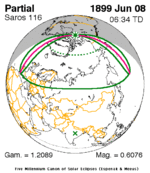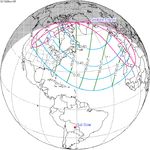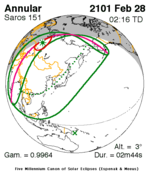A partial solar eclipse occurred at the Moon's ascending node of orbit on Friday, October 31, 1902,[1] with a magnitude of 0.696. A solar eclipse occurs when the Moon passes between Earth and the Sun, thereby totally or partly obscuring the image of the Sun for a viewer on Earth. A partial solar eclipse occurs in the polar regions of the Earth when the center of the Moon's shadow misses the Earth.
Related eclipses
Eclipses in 1902
- A partial solar eclipse on April 8, 1902.
- A total lunar eclipse on April 22, 1902.
- A partial solar eclipse on May 7, 1902.
- A total lunar eclipse on October 17, 1902.
- A partial solar eclipse on October 31, 1902.
Metonic
- Preceded by: Solar eclipse of January 11, 1899
- Followed by: Solar eclipse of August 20, 1906
Tzolkinex
- Preceded by: Solar eclipse of September 18, 1895
- Followed by: Solar eclipse of December 12, 1909
Half-Saros
- Preceded by: Lunar eclipse of October 25, 1893
- Followed by: Lunar eclipse of November 6, 1911
Tritos
- Preceded by: Solar eclipse of December 1, 1891
- Followed by: Solar eclipse of September 30, 1913
Solar Saros 151
- Preceded by: Solar eclipse of October 19, 1884
- Followed by: Solar eclipse of November 10, 1920
Inex
- Preceded by: Solar eclipse of November 20, 1873
- Followed by: Solar eclipse of October 11, 1931
Triad
- Preceded by: Solar eclipse of December 30, 1815
- Followed by: Solar eclipse of August 31, 1989
Solar eclipses of 1898–1902
This eclipse is a member of the 1898–1902 solar eclipse semester series. An eclipse in a semester series of solar eclipses repeats approximately every 177 days and 4 hours (a semester) at alternating nodes of the Moon's orbit.
| Solar eclipse series sets from 1898 to 1902 | ||||
|---|---|---|---|---|
| Ascending node | Descending node | |||
| 111 | December 13, 1898 Partial |
116 | June 8, 1899 Partial | |
| 121 | December 3, 1899 Annular |
126 | May 28, 1900 Total | |
| 131 | November 22, 1900 Annular |
136 | May 18, 1901 Total | |
| 141 | November 11, 1901 Annular |
146 | May 7, 1902 Partial | |
| 151 | October 31, 1902 Partial | |||
Note: The partial solar eclipse of April 8, 1902, the annular solar eclipse of March 29, 1903 and the total solar eclipse of September 21, 1903 occur during the next lunar year set.
Saros 151
It is a part of Saros cycle 151, repeating every 18 years, 11 days, containing 72 events. The series started with partial solar eclipse on August 14, 1776. It contains annular eclipses from February 28, 2101, through April 23, 2191, a hybrid eclipse on May 5, 2209, and total eclipses from May 16, 2227, through July 6, 2912. The series ends at member 72 as a partial eclipse on October 1, 3056. The longest duration of totality will be 5 minutes, 41 seconds on May 22, 2840.
| Series members 8-24 occur between 1901 and 2200: | ||
|---|---|---|
| 8 | 9 | 10 |
 October 31, 1902 |
 November 10, 1920 |
 November 21, 1938 |
| 11 | 12 | 13 |
 December 2, 1956 |
 December 13, 1974 |
 December 24, 1992 |
| 14 | 15 | 16 |
 January 4, 2011 |
 January 14, 2029 |
 January 26, 2047 |
| 17 | 18 | 19 |
 February 5, 2065 |
 February 16, 2083 |
 February 28, 2101 |
| 20 | 21 | 22 |
 March 11, 2119 |
 March 21, 2137 |
 April 2, 2155 |
| 23 | 24 | |
 April 12, 2173 |
 April 23, 2191 | |
Notes
References
- Earth visibility chart and eclipse statistics Eclipse Predictions by Fred Espenak, NASA/GSFC





Recent Comments